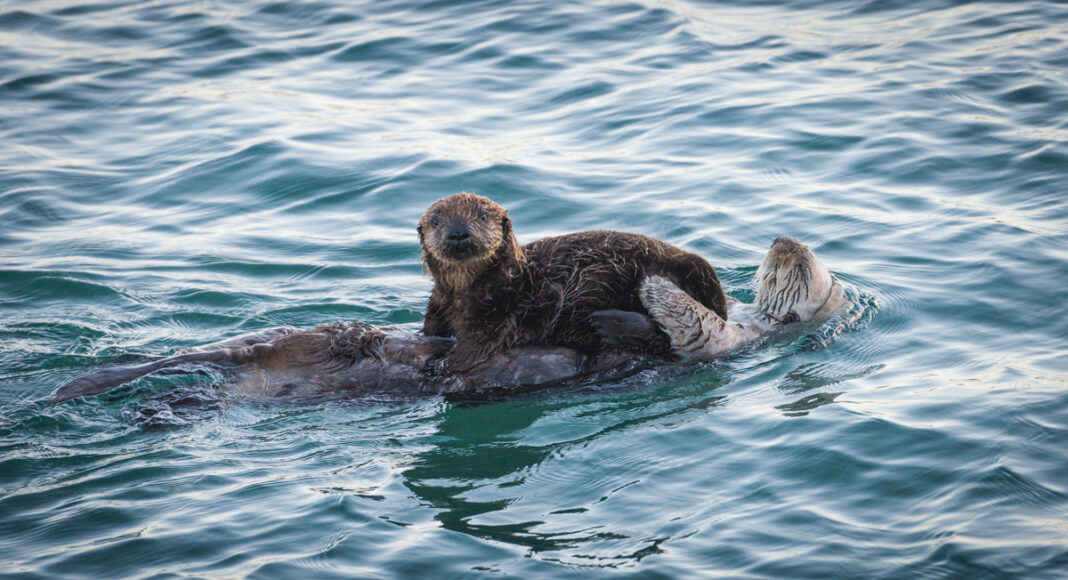A new study from UCSC, the Monterey Bay Aquarium and the U.S. Geological Survey highlights the role of otters in maintaining local kelp forests amid urchin outbreaks.
Less than 10 years ago, iconic giant kelp dominated the underwater landscapes of the Monterey Bay. “These were towering, tall underwater forests that resembled their terrestrial redwood forest counterparts,” says Joshua Smith, a UCSC Ph.D. candidate and the lead author on the study.
But the forests look different now. They’re patchy—broken up by rock fields covered in purple sea urchins. Researchers call these underwater deserts “urchin barrens.”
The barrens formed under a perfect storm of events. As urchin populations increased, sea star wasting syndrome wiped out one of their main predators—sunflower sea stars—in 2013. The next year, a major marine heatwave slowed the growth of kelp.
“Normally, sea urchins live down in the rock crevices and eat drift kelp,” says Smith. Drift kelp, he explains, is like leaves that fall from trees. But after the warm water damaged the kelp, less of it made its way to the cracks in the reef.
“The pizza is not being delivered to the doorstep. They’ve gotta go out and look for it,” says Steve Lonhart, a research ecologist at the Monterey Bay National Marine Sanctuary who was not involved in the study. “It’s also helpful that one of the things that might eat them is not around, so there’s a little bit less of the sense of fear in the water.”
The urchins crawled out of their holes and began mowing down live kelp. They overwhelmed entire forests then sat dormant on the rocks, waiting for any available scrap of food.

Diving into Data
As urchin numbers increased, researchers wondered how otters and the ecosystem as a whole would respond. Sea otters feed on small, slow-moving animals like urchins and eat around a fourth of their body weight each day.
“They are voracious predators,” says Lonhart. With these enormous appetites, otters help keep kelp forests in balance.
To learn more about how the behaviors of otters and urchins affect kelp forests, scientists set out on a three-year study. They reviewed 20 years of sea otter census data and monitored hundreds of sites around the Monterey Peninsula.
A land-based team watched and recorded the locations of otters feeding on urchins. A dive group then surveyed the areas. “Our team spent hundreds of long, cold hours underwater,” says Smith.
They recorded the amount of kelp and urchins at the sites and collected a few urchins to dissect in a lab. Then they repeated the process at areas where otters were not eating urchins.
The scientists found that otter numbers increased after the urchin explosion. The predators also began developing a taste for the spiky prey. “A lot more otters were focusing on urchins than in previous years,” says Jessica Fujii, assistant manager of sea otter research at the Monterey Bay Aquarium and a co-author on the study.
But the group found that otters only feed on urchins in kelp forests. They ignore the barrens. When the scientists opened urchins from the underwater deserts, the reason became clear.
“Sea urchins that live in these patches of kelp forests are really healthy,” says Smith. “But those in the barrens are completely starved out.” The dormant, nearly-empty urchins are “just not worth the otter’s time.”

Finding Balance
By increasing the proportion of urchins in their diet and focusing on kelp forests, otters defend the existing kelp. This protection could become a key factor in restoring healthy forests.
“Those patches of forests maintained by otters are the ultimate spore sources to help replenish the barren areas,” says Smith. But since otters don’t pick urchins off barrens, something else must take them out.
“When you’re in this urchin-dominated system, it may be very difficult to displace it back to the kelp unless there’s some sort of large disturbance such as disease for the urchins, or large storm events,” says Lonhart.
Urchins currently get a bad rap, but researchers want people to know that they’re not inherently harmful. “Otters need urchins as a source of food,” says Fujii. “Ideally, what we would like to see is a balance of all those different key players for a healthy kelp forest ecosystem.”
Some scientists hope a recovery of the sunflower sea star could bring that balance. Others don’t think it would help. “I would argue that chances are, they would be overwhelmed,” says Lonhart.
Uncertainty also surrounds the otter population. “The next question,” says Fujii, “is what’s going to happen as those healthy sea urchins start to become depleted.” The number of local otters has already decreased compared to the early years of the urchin boom, she says.
The new study highlights how the behavior of a few key species can change entire ecosystems, but the forests’ futures are still unpredictable. “This system is so dynamic and complex,” says Smith.
Researchers expect to spend the next several years watching the natural experiment of kelp forests and urchin barrens unfold. “At this point,” says Fujii, “there’s still a lot of unknowns about what’s going to come next.”













